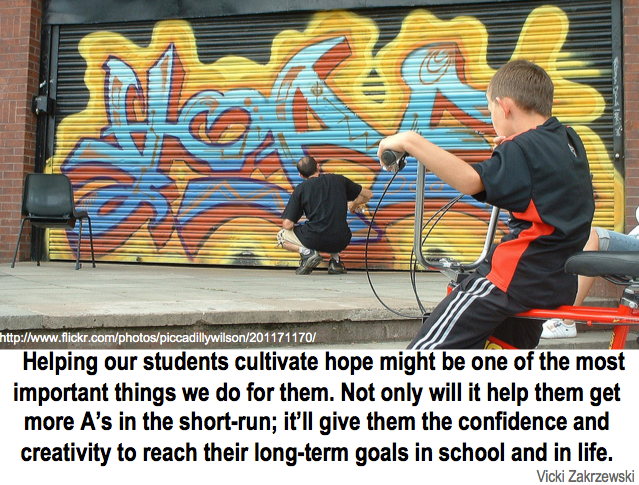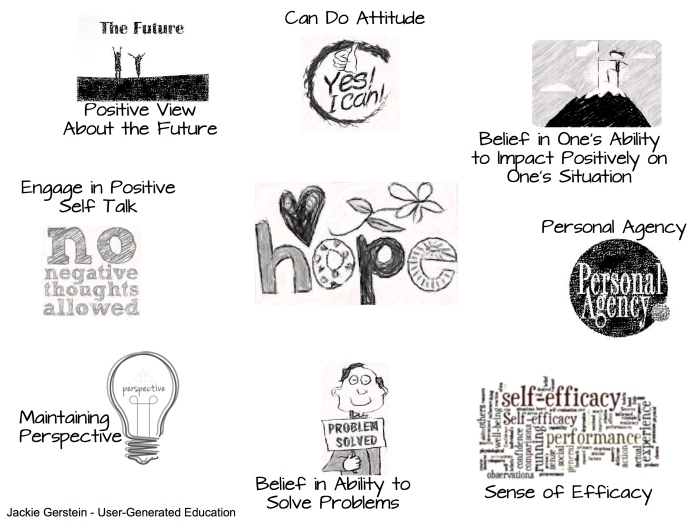Educators as Purveyors of Hope

My advanced degree is in counseling. I sought this degree due to my affinity towards at-risk and adjudicated youth. One of the most powerful learnings from my training as a counselor was a comment I heard at a conference, Counselors need to be purveyors of hope since many clients get in trouble and/or seek counseling due to a lack of hope.
I have since become a teacher educator (with some teaching of elementary gifted students at a few Title 1 schools thrown in). I believe that educators do more counseling of children and young people than any other profession. Teachers, then, should be purveyors of hope especially for those students who lack the belief in their own capabilities and potential This includes students who lack hope that they can do well in certain subjects; students who lack hope that they can do well in school-as-a-whole; and saddest of all, students who lack hope for their futures. The educator, as a purveyor of hope, gives these types of learners the overt message, “I will hold hope for you because I believe in you. The goal, though, is for you to develop your own sense of hope.”
Hope often gets a bad rap. For some, it conjures up images of a blissfully naïve chump pushing up against a wall with a big smile. That’s a shame. Cutting-edge science shows that hope, at least as defined by psychologists, matters a lot.
Hope is not just a feel-good emotion, but a dynamic cognitive motivational system. Under this conceptualization of hope, emotions follow cognitions, not the other way round. Hope-related cognitions are important. Hope leads to learning goals, which are conducive to growth and improvement. People with learning goals are actively engaged in their learning, constantly planning strategies to meet their goals, and monitoring their progress to stay on track. A bulk of research shows that learning goals are positively related to success across a wide swatch of human life—from academic achievement to sports to arts to science to business. In contrast to both self-efficacy and optimism, people with hope have the will and the pathways and strategies necessary to achieve their goals (The Will and Ways of Hope).
Over the last 20 years, researchers have gained a clearer understanding of the relationships between hope and important aspects of students’ lives. Put simply, research demonstrates that more hopeful students do better in school and life than less hopeful students.
- Hope is positively associated with perceived competence and self-worth (Marques, Pais-Ribeiro, & Lopez, 2009) and negatively associated with symptoms of depression (Snyder, Hoza, et al., 1997).
- High-hope students typically are more optimistic (Snyder, Hoza, et al., 1997), develop many life goals, and perceive themselves as being capable of solving problems that may arise (Snyder, Hoza, et al., 1997).
- Accumulating evidence suggests that hope is related to life satisfaction and wellbeing (e.g., Gilman, Dooley, & Florell, 2006).
- Hope is linked consistently to attendance and credits earned (Gallup, 2009a).
- Hopeful middle school students have better grades in core subjects (Marques, Pais-Ribeiro, & Lopez, 2011) and on achievement tests (Snyder, Hoza, et al., 1997).
- Hopeful high school students (Gallup, 2009b; Snyder et al., 1991) and beginning college students (Gallagher & Lopez, 2008; Snyder et al., 2002) have higher overall grade point averages.
- Hope predicts academic achievement, and the predictive power of hope remains significant even when controlling for intelligence (e.g., Snyder, Cheavens, & Sympson, 1997), prior grades (e.g., Gallagher & Lopez, 2008; Snyder et al., 1991; Snyder et al., 2002), self-esteem (Snyder et al., 2002), personality (Day, Hanson, Maltby, Proctor, & Wood, 2010), and college entrance examination scores such as high school GPA and ACT/SAT (Gallagher & Lopez, 2008; Snyder et al., 2002).
- Higher hope has been correlated positively with social competence (Barnum, Snyder, Rapoff, Mani, & Thompson, 1998), pleasure in getting to know others, enjoyment in frequent interpersonal interactions (Snyder, Hoza, et al., 1997), and interest in the goal pursuits of others (Snyder, Cheavens, & Sympson, 1997). (Measuring and Promoting Help in Schoolchildren)
Some of the characteristics or skills sets of hope include:
- Positive View About the Future
- Can Do Attitude
- Personal Agency
- Engage in Positive Self Talk
- Belief in Ability to Solve Problems
- Belief in One’s Ability to Impact Positively on One’s Situation.
- Maintaining Perspective
- Sense of Efficacy

For educators who want to help their students build these skills of hope, here are five research-based guidelines. From How to Help Students Develop Hope:
- Identify and prioritize their top goals, from macro to micro. Start by having students create a “big picture” list of what’s important to them—such as their academics, friends, family, sports, or career—and then have them reflect on which areas are most important to them and how satisfied they are with each.
- Breakdown the goals—especially long-term ones—into steps. Research has suggested that students with low hope frequently think goals have to be accomplished all-at-once, possibly because they haven’t had the parental guidance on how to achieve goals in steps. Teaching them how to see their goals as a series of steps will also give students reasons to celebrate their successes along the way—a great way to keep motivation high!
- Teach students that there’s more than one way to reach a goal. Studies show that one of the greatest challenges for students with low hope is their inability to move past obstacles. They often lack key problem-solving skills, causing them to abandon the quest for their goals.
- Tell stories of success. Scientists have found that hopeful students draw on memories of other successes when they face an obstacle; however, students with low hope often don’t have these kinds of memories. That’s why it’s vital for teachers to read books or share stories of other people—especially kids—who have overcome adversity to reach their goals.
- Keep it light and positive. It’s important to teach students to enjoy the process of attaining their goals, even to laugh at themselves when they face obstacles and make mistakes. Above all, no self-pity! Research has found that students who use positive self-talk, rather than beating themselves up for mistakes, are more likely to reach their goals.
Parting Shot: I recently watched the documentary STEP, which provides a great example of administrators and teachers instilling hope into a marginalized population.
STEP documents the senior year of a girls’ high-school step dance team against the background of inner-city Baltimore. These young women learn to laugh, love and thrive – on and off the stage – even when the world seems to work against them. Empowered by their teachers, teammates, counselors, coaches and families, they chase their ultimate dreams: to win a step championship and to be accepted into college. This all female school is reshaping the futures of its students’ lives by making it their goal to have every member of their senior class accepted to and graduate from college, many of whom will be the first in their family to do so (http://www.foxsearchlight.com/stepmovie/).
Written by Jackie Gerstein, Ed.D.
January 5, 2018 at 10:40 pm
Posted in Education
Tagged with 21st century skills, emotional intelligence, hope, professional development, social-emotional learning
One Response
Subscribe to comments with RSS.
Leave a comment Cancel reply
This site uses Akismet to reduce spam. Learn how your comment data is processed.

Thank you for this wonderful article and for providing concrete steps teachers can take. Most of the youth I have worked with that experience mental health challenges and substance abuse disorders have lost hope! It seems that until they regain hope healing cannot occur; because they do not believe that things will change for the better anyway! I have also seen that when even ONE teacher believes in them and their ability to be successful and happy – the light starts coming back on!
R.Harwick,PhD
January 7, 2018 at 4:48 pm